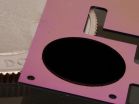(Press-News.org) This press release is available in German.
The detector combines near-unity detection efficiency with high timing resolution and has a very low error rate. The results have been published by Nature Communications (doi:10.1038/ncomms2307).
Ultrafast, efficient, and reliable single-photon detectors are among the most sought-after components in photonics and quantum communication, which have not yet reached maturity for practical application. Physicist Dr. Wolfram Pernice of the Karlsruhe Institute of Technology (KIT), in cooperation with colleagues at Yale University, Boston University, and Moscow State Pedagogical University, achieved the decisive breakthrough by integrating single-photon detectors with nanophotonic chips. The detector combines near-unity detection efficiency with high timing resolution and has a very low error rate. The results have been published by Nature Communications (doi:10.1038/ncomms2307).
Without reliable detection of single photons, it is impossible to make real use of the latest advances in optical data transmission or quantum computation; it is like having no analog-digital converter in a conventional computer to determine whether the applied voltage stands for 0 or 1. Although a number of different single-photon detector models have been developed over the past few years, thus far, none have provided satisfactory performance.
Several new ideas and advanced developments went into the prototype developed within the "Integrated Quantum Photonics" project at the DFG Center of Functional Nanostructures (CFN). The new single-photon detector, tested in the telecommunications wavelength range, achieves a previously unattained detection efficiency of 91%.
The detector was realized by fabricating superconducting nanowires directly on top of a nanophotonic waveguide. This geometry can be compared to a tube that conducts light, around which a wire in a superconducting state is wound and, as such, has no electric resistivity. The nanometer-sized wire made of niobium nitride absorbs photons that propagate along the waveguide. When a photon is absorbed, superconductivity is lost, which is detected as an electric signal. The longer the tube, the higher is the detection probability. The lengths involved are in the micrometer range.
A special feature of the detector is its direct installation on the chip, which allows for it to be replicated at random. The single-photon detectors built thus far were stand-alone units, which were connected to chips with optical fibers. Arrangements of that type suffer from photons being lost in the fiber connection or being absorbed in other ways. These loss channels do not exist in the detector that is now fully embedded in a silicon photonic circuit. In addition to high detection efficiency, this gives rise to a remarkably low dark count rate. Dark counts arise when a photon is detected erroneously: for instance, because of a spontaneous emission, an alpha particle, or a spurious field. The new design also provides ultrashort timing jitter of 18 picoseconds, which is 18 times 10-12 seconds.
The novel solution also makes it possible to integrate several hundreds of these detectors on a single chip. This is a basic precondition for future use in optical quantum computers.
The detector demonstrated in this study was designed to work at wavelengths in the Telekom bandwidth. The same detector architecture can also be used for wavelengths in the range of visible light. This would allow the principle to be employed in analyses of all structures that emit little light, i.e., photons, such as single molecules or bacteria.
INFORMATION:
C.V. Dr. Wolfram Pernice
Dr. Wolfram Pernice studied Microsystems Technology at Albert Ludwig University in Freiburg. After winning a research grant of the British Engineering and Physical Sciences Research Council he obtained his Ph.D. at the University of Oxford, England where he explored the Development of Efficient Numerical Methods for Simulating Photonic Devices. In 2008 he joined Yale University where, supported by a Humboldt scholarship, he analyzed nano-opto-mechanical systems in the group of Hong Tang. In summer 2011, the German Research Association (DFG) appointed him as head of an Emmy Noether Research Group. His research into integrated quantum optical and nano-opto-mechanical systems had convinced the committee, and as the recipient of an Emmy Noether grant, he chose to pursue his work at the Karlsruhe Institute of Technology (KIT). Since October 2011, he has worked here as a Junior Group Leader at the Institute of Nanotechnology (INT). At the beginning of the year, he also won a Helmholtz International Research Group grant, which he wants to use to fund another post-graduate student in his Karlsruhe team.
The DFG Center of Functional Nanostructures (CFN) devotes its attention to the important area of nanotechnology and functional nanostructures. Its objective is to carry out excellent interdisciplinary and international research in order to produce nanostructures with new technical functions and take the first step from fundamental research to application. At the present time, more than 250 scientists and engineers cooperate in more than 80 sub-projects networked through the CFN in Karlsruhe, focusing on the areas of nano-photonics, nano-electronics, molecular nanostructures, nano-biology, and nano-energy. www.cfn.kit.edu
The Karlsruhe Institute of Technology (KIT) is a public corporation according to the legislation of the state of Baden-Württemberg. It fulfills the mission of a university and the mission of a national research center of the Helmholtz Association. KIT focuses on a knowledge triangle that links the tasks of research, teaching, and innovation.
This press release is available on the Internet at www.kit.edu.
A print-quality photo may be downloaded under www.kit.edu or requested by mail (presse@kit.edu) or phone (+49 721 608-47414). The photo may only be used in the context mentioned above.
Quantum communication: Each photon counts
2013-01-25
ELSE PRESS RELEASES FROM THIS DATE:
NIST's 'nanotubes on a chip' may simplify optical power measurements
2013-01-25
The National Institute of Standards and Technology (NIST) has demonstrated a novel chip-scale instrument made of carbon nanotubes that may simplify absolute measurements of laser power, especially the light signals transmitted by optical fibers in telecommunications networks.
The prototype device, a miniature version of an instrument called a cryogenic radiometer, is a silicon chip topped with circular mats of carbon nanotubes standing on end.* The mini-radiometer builds on NIST's previous work using nanotubes, the world's darkest known substance, to make an ultraefficient, ...
Analysis of Greenland ice cores adds to historical record and provide glimpse into climate's future
2013-01-25
A new study that provides surprising details on changes in Earth's climate from more than 100,000 years ago indicates that the last interglacial--the period between "ice ages"--was warmer than previously thought and may be a good analog for future climate, as greenhouse gases increase in the atmosphere and global temperatures rise.
The research findings also indicate that melting of the massive West Antarctic ice sheet may have contributed more to sea-level rise at that time than melting of the Greenland ice sheet.
The new results from the North Greenland Eemian Ice ...
Emotional stress reduces effectiveness of prostate cancer therapies in animal model
2013-01-25
WINSTON-SALEM, N.C. – Jan. 25, 2013 – Not surprisingly, a cancer diagnosis creates stress. And patients with prostate cancer show higher levels of anxiety compared to other cancer patients.
A new study by researchers at Wake Forest Baptist Medical Center indicates that stress is not just an emotional side effect of the diagnosis; it also can reduce the effectiveness of prostate cancer drugs and accelerate the development of prostate cancer.
The findings are published in the February issue of the Journal of Clinical Investigation.
The Wake Forest Baptist team, headed ...
INRS develops a nanohybrid with remarkable properties using a new laser-plasma process
2013-01-25
Montreal, January 25, 2013 – By achieving the synthesis of a novel nanohybrid structure by means of the pulsed laser ablation (PLA) technique, Professor My Ali El Khakani and his team paved the way for a new generation of optoelectronic materials. The combination of carbon nanotubes and lead sulfide (PbS) nanoparticles was performed using an effective and relatively simple process that offers considerable latitude for creating other nanohybrids for a variety of applications. The INRS Énergie Matériaux Télécommunications Research Centre researcher's work, published in the ...
No more 'empty nest:' middle-aged adults face family pressure on both sides
2013-01-25
CORVALLIS, Ore. – The "empty nest" of past generations, in which the kids are grown up and middle-aged adults have more time to themselves, has been replaced in the United States by a nest that's full – kids who can't leave, can't find a job and aging parents who need more help than ever before.
According to a new study by researchers at Oregon State University, what was once a life stage of new freedoms, options and opportunities has largely disappeared.
An economic recession and tough job market has made it hard on young adults to start their careers and families. ...
New tool for mining bacterial genome for novel drugs
2013-01-25
Vanderbilt biochemists have discovered that the process bacteria undergo when they become drug resistant can act as a powerful tool for drug discovery.
Their findings – reported this week in the Online Early Edition of the Proceedings of the National Academy of Sciences – should give a major boost to natural products drug discovery – the process of finding new drugs from compounds isolated from living organisms – by substantially increasing the number of novel compounds that scientists can extract from individual microorganisms.
Bacteria have traditionally been the ...
New suite of chemicals seen causing disease generations later
2013-01-25
PULLMAN, Wash.—Washington State University researchers have lengthened their list of environmental toxicants that can negatively affect as many as three generations of an exposed animal's offspring.
Writing in the online journal PLOS ONE, scientists led by molecular biologist Michael Skinner document reproductive disease and obesity in the descendants of rats exposed to the plasticizer bisephenol-A, or BPA, as well DEHP and DBP, plastic compounds known as phthalates.
In a separate article in the journal Reproductive Toxicology, they report the first observation of cross-generation ...
Breast feeding okay for mothers taking immunosuppressant drug
2013-01-25
Highlights
The breast milk of mothers taking the immunosuppressant tacrolimus contains only very low levels of the drug.
Women taking tacrolimus who wish to breast-feed after appropriate counseling should not be discouraged from doing so.
Increasing numbers of pregnant women are taking tacrolimus after organ transplantation and for other conditions.
Washington, DC (January 24, 2013) — Women taking the immunosuppressant tacrolimus can rest assured that breast feeding will not elevate their babies' exposure to the drug, according to a study appearing in an upcoming ...
Kidney disease accounts for most of the increased risk of dying early among diabetics
2013-01-25
Highlights
Among people without diabetes or kidney disease, 10-year mortality was 7.7%.
Among individuals with diabetes but without kidney disease, mortality was 11.5%.
Among those with both diabetes and kidney disease, mortality was 31.1%.
26 million people in the US and 340 million people in the world have type 2 diabetes.
Washington, DC (January 24, 2013) — One in every 10 Americans has diabetes, and a third or more of those with the condition will develop kidney disease. It may be possible to live a long and healthy life with diabetes, but once kidney disease ...
Love triumphs over hate to make exotic new compound
2013-01-25
Northwestern University graduate student Jonathan Barnes had a hunch for creating an exotic new chemical compound, and his idea that the force of love is stronger than hate proved correct. He and his colleagues are the first to permanently interlock two identical tetracationic rings that normally are repelled by each other. Many experts had said it couldn't be done.
On the surface, the rings hate each other because each carries four positive charges (making them tetracationic). But Barnes discovered by introducing radicals (unpaired electrons) onto the scene, the researchers ...


